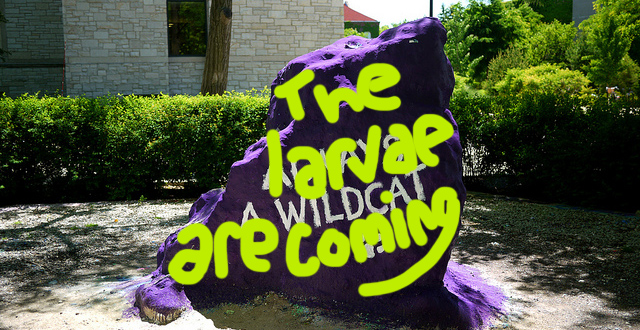Spawn overrun campus after rock hatches
A mysterious contagion continues to plague Northwestern University and the greater Evanston area. On September the 15th the Northwestern Rock, a famous university touchstone, hatched open, unleashing hundreds upon hundreds of young larvae upon the campus. The spawn tend to travel in groups, spouting incoherent phrases such as “ENU,” “Henry Crown Center,” and “Meet me at Norris!” At night many can be found swarming aimlessly through the neighborhoods west of campus. However, aside from the damage to the occasional front lawn the creatures seem relatively harmless.
Evanston residents and university officials are equally mystified as to the appearance of this infestation, as well as concerned about its duration, prompting many to ask the question, “What are these strange creatures and where did they come from?”
Chuck Cobbler, Northwestern’s premiere professor of entomology, has some answers.
Says Cobbler, “I’ve seen plagues of this kind in schools before. Universities are especially vulnerable in autumn. It was only a matter of time.” This particular strain is classified as Calliphoridae freshmen. Cobbler adds, “While the calliphoridae are a bit of a nuisance, they do not pose any imminent threat.”
The life cycle of the organisms is broken down into three stages. “Upon hatching,” says Cobbler, “the immediate instinct of the larvae is to feed. After the dormancy of the hive, these grubs are restless and ravenous. They will gorge themselves on rotting garbage carrion, anything from Busch Light to Burger King.” He adds, “They are also incredibly sexually driven. A newly hatched calliphoridae will mate with anything on segmented thoracic legs.”
According to Petyr Stine, a PhD candidate in Insect Sciences, the initial stage of the life cycle lasts for roughly three to four weeks. Eventually, the shock of new surroundings and the intense pressures of a demanding work environment overwhelm the calliphoridae. Missing the comfort and safety of their former hive, they retreat in solitude to burrow and pupate. While this phase usually lasts no more than a month or two, Stine predicts that the harsh Evanston winter could significantly extend the pupation process.
“Eventually,” says Stine, “the calliphoridae will emerge from their individual cocoons as mature organisms. The adults will soon integrate themselves into the greater campus culture, sucking down nectar from budding Skol blossoms and swarming Sheridan Road like the rest of those undergraduate parasites.”
As for where did they come from? Stine speculates that the mutation originated from layers and layers of lead paint corroding the Rock over the last fifty-odd years.
And for how long will they last? Says Chuck Cobbler, “Once they’re here, you can’t get rid of them. I suspect they’ve begun laying their eggs on the lakefill rocks and in fraternity basements as we speak.”
According to Cobbler, the next wave can be expected in September of 2015. He suggests we prepare accordingly.
WELCOME TO NORTHWESTERN, LITTLE MAGGOTS WILDCATS!








